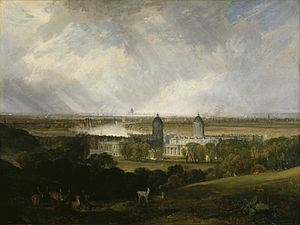Greenwich Park
One of the eight Royal Parks of London, and the first to be enclosed (in 1433), it covers 74 hectares (180 acres),[1] and is part of the Greenwich World Heritage Site.
Surrounding the hilltop Royal Observatory (opened in 1676) and straddling the Greenwich Prime Meridian, it commands elevated views over the River Thames, the Isle of Dogs and the City of London.
The park is open year-round, and incorporates flower gardens as well as grassy spaces, a children's playground, cafés and other amenities, a bandstand, a boating lake, a pond, wooded areas, and a wildlife habitat called 'The Wilderness'.
The estate of some 200 acres (81 ha) was originally owned by Saint Peter's Abbey, Ghent, but reverted to the Crown in 1427 and was given by Henry VI to his uncle Humphrey, Duke of Gloucester.
Greenwich Castle, by now in disrepair, was chosen for the site of the Royal Observatory by Charles II in 1675, on the advice of Sir Christopher Wren.
James I enclosed the park with a brick wall, 12 feet (3.7 m) high and two miles (3 km) long at a cost of £2000, much of which remains and defines the modern boundary.
However, the London and Greenwich Railway was later extended beneath the ground via a cut-and-cover tunnel link between Greenwich and Maze Hill which opened in 1878 (the tunnel alignment is on the north side of the park's northern boundary wall, running beneath the gardens of the National Maritime Museum and Queen's House).
The victim, Martial Bourdin, was a 26-year-old Frenchman with links to the anarchist Club Autonomie, and was carrying the device when it exploded prematurely.
[12] During World War II anti-aircraft guns were positioned in the park’s flower garden with some tree tops removed to clear the line of fire.
[3] Supported by a grant of £4,517,300 from the National Lottery Heritage Fund and the National Lottery Community Fund,[3][18] the project will remodel the area around the General Wolfe statue viewpoint,[19] restore the 'Grand Ascent' (a series of giant grass steps, north of the Wolfe statue),[8] restore other landscape features, replant tree avenues,[20] and add a £1.2m learning centre (designed by Architype),[21] a café and other visitor facilities.
[22][23] Several archaeological investigations have been undertaken in parallel with the work, including 2021 and 2022 digs of a Saxon burial mound, a 2023 dig on the site of the 'Grand Ascent', a community excavation of a World War II air-raid shelter east of One Tree Hill, and exploration of the remains of John Pond’s Magnetic Observatory,[24] an enclosure built in 1817 to analyse Earth's magnetic field.
The lower level (closest to the National Maritime Museum, Queen's House and, beyond them, the Thames) lies to the north; from there a steep walk uphill reveals the southern part – a flat expanse that is, essentially, an enclosed extension of the plateau of Blackheath.
[30][31] West of the Observatory is the garden of the former Astronomer Royal, a peaceful secluded space which is good for picnics and also sometimes used by theatre groups (Midsummer Night's Dream, etc.).
Greenwich Park was used for outdoor London scenes including representing the Constitution Hill thoroughfare in the 2009 film The Young Victoria starring Emily Blunt and Rupert Friend.




